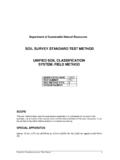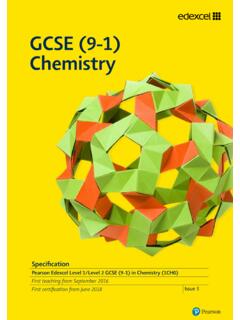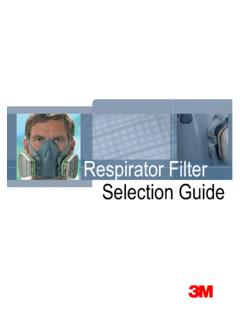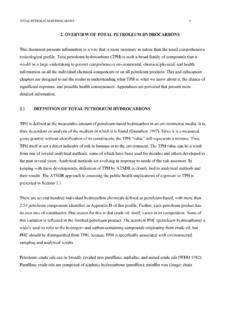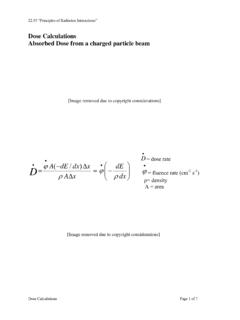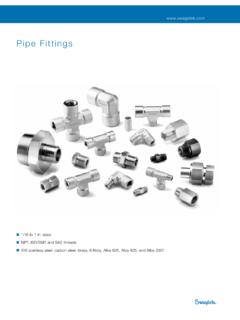Transcription of ASBESTOS (bulk) by PLM 9002
1 ASBESTOS ( bulk ) by plm 9002. various MW: various CAS: 1332-21-4 RTECS: C16475000. METHOD: 9002, Issue 2 EVALUATION: PARTIAL Issue 1: 15 May 1989. Issue 2: 15 August 1994. EPA Standard ( bulk ): 1% PROPERTIES: solid, fibrous, crystalline, anisotropic SYNONYMS [CAS #]: actinolite [77536-66-4], or ferroactinolite [15669-07-5]; amosite [12172-73-5]; anthophyllite [77536-67-5];. chrysotile [12001-29-5]; serpentine [18786-24-8]; crocidolite [12001-28-4]; tremolite [77536-68-6]; amphibole. SAMPLING MEASUREMENT. bulk SAMPLE: 1 to 10 grams TECHNIQUE: MICROSCOPY, STEREO AND. POLARIZED LIGHT, WITH. DISPERSION STAINING. SHIPMENT: seal securely to prevent escape of ASBESTOS ANALYTE: actinolite ASBESTOS , amosite, anthophyllite ASBESTOS , chrysotile, SAMPLE crocidolite, tremolite ASBESTOS STABILITY: stable EQUIPMENT: microscope, polarized light; 100-400X.
2 BLANKS: none required dispersion staining objective, stereo microscope: 10-45X. RANGE: 1% to 100% ASBESTOS ACCURACY ESTIMATED LOD: <1% ASBESTOS [1]. PRECISION: not determined RANGE STUDIED: <1% to 100% ASBESTOS BIAS: not determined PRECISION: not determined ACCURACY: not determined APPLICABILITY: this method is useful for the qualitative identification of ASBESTOS and the semi-quantitative determination of ASBESTOS content of bulk samples. The method measures percent ASBESTOS as perceived by the analyst in comparison to standard area projections, photos, and drawings, or trained experience. The method is not applicable to samples containing large amounts of fine fibers below the resolution of the light microscope INTERFERENCES: Other fibers with optical properties similar to the ASBESTOS minerals may give positive interferences.
3 Optical properties of ASBESTOS may be obscured by coating on the fibers. Fibers finer than the resolving power of the microscope (ca. m). will not be detected. Heat and acid treatment may alter the index of refraction of ASBESTOS and change its color. OTHER METHODS: This method (originally designated as method 7403) is designed for use with NIOSH Methods 7400 (phase contrast microscopy) and 7402 (electron microscopy/EDS). The method is similar to the EPA bulk ASBESTOS method [1]. NIOSH Manual of Analytical Methods (NMAM), Fourth Edition, 8/15/94. ASBESTOS ( bulk ): METHOD 9002, Issue 2, dated 15 August 1994 - Page 2 of 9.
4 REAGENTS: EQUIPMENT: 1. Refractive index (RI) liquids for Dispersion 1. Sample containers: screw-top plastic vials of Staining: high-dispersion (HD) series, , 10- to 50-mL capacity. , 2. Microscope, polarized light, with polarizer, 2. Refractive index liquids: , , and analyzer, port for retardation plate, 360E. graduated rotating stage, substage condenser 3. ASBESTOS reference samples such as SRM with iris, lamp, lamp iris, and: #1866, available from the National Institute of a. Objective lenses: 10X, 20X, and 40X or Standards and Technology.* near equivalent. 4. Distilled Water (optional). b. Ocular lense: 10X minimum.
5 5. Concentrated HCl: ACS reagent grade. c. Eyepiece reticle: crosshair. d. Dispersion staining objective lens or equivalent. e. Compensator plate: ca. 550 nm 20 nm, retardation: "first order red". compensator. * See SPECIAL PRECAUTIONS 3. Microscope slides: 75 mm x 25 mm. 4. Cover slips. 5. Ventilated hood or negative-pressure glove box. 6. Mortar and pestle: agate or porcelain. 7. Stereomicroscope, ca. 10 to 45X. 8. Light source: incandescent or fluorescent. 9. Tweezers, dissecting needles, spatulas, probes, and scalpels. 10. Glassine paper or clean glass plate. 11. Low-speed hand drill with coarse burr bit (optional).
6 SPECIAL PRECAUTIONS: ASBESTOS , a human carcinogen, should be handled only in an exhaust hood (equipped with a HEPA filter) [2]. Precautions should be taken when collecting unknown samples, which may be ASBESTOS , to preclude exposure to the person collecting the sample and minimize the disruption to the parent material [3]. Disposal of ASBESTOS -containing materials should follow EPA Guidelines [4]. SAMPLING: 1. Place 1 to 10 g of the material to be analyzed in a sample container. NOTE: For large samples ( , whole ceiling tiles) that are fairly homogenous, a representative small portion should be submitted for analysis.
7 Sample size should be adjusted to ensure that it is representative of the parent material. 2. Make sure that sample containers are taped so they will not open in transit. 3. Ship the samples in a rigid container with sufficient packing material to prevent damage or sample loss. SAMPLE PREPARATION: 4. Visually examine samples in the container and with a low-magnification stereomicroscope in a hood. (If necessary, a sample may be carefully removed from the container and placed on glassine transfer paper or clean glass plate for examination). Break off a portion of the sample and examine the edges for emergent fibers.
8 Note the homogeneity of the sample. Some hard tiles can be broken, and the edges examined for emergent fibers. If fibers are found, make an estimate of the amount and type of fibers present, confirm fiber type (step 14) and quantify (step 15). 5. In a hood, open sample container and with tweezers remove small, representative portions of the sample. 1. If there are obvious separable layers, sample and analyze each layer separately. NIOSH Manual of Analytical Methods (NMAM), Fourth Edition, 8/15/94. ASBESTOS ( bulk ): METHOD 9002, Issue 2, dated 15 August 1994 - Page 3 of 9. b. If the sample appears to be slightly inhomogeneous, mix it in the sample container with tweezers or a spatula before taking the portion of analysis.
9 Alternatively, take small representative portions of each type of material and place on a glass slide. c. On hard tiles that may have thin, inseparable layers, use a scalpel to cut through all the layers for a representative sample. Then cut it into smaller pieces after placing RI liquid on it before trying to reduce the thickness. Alternatively, use a low-speed hand drill equipped with a burr bit to remove material from hard tiles. Avoid excessive heating of the sample which may alter the optical properties of the material. NOTE: This type of sample often requires ashing or other specialized preparation, and may require transmission electron microscopy for detection of the short ASBESTOS fibers which are characteristic of floor tiles.
10 D. If the sample has large, hard particles , grind it in a mortar. Do not grind so fine that fiber characteristics are destroyed. e. If necessary, treat a portion of the sample in a hood with an appropriate solvent to remove binders, tars, and other interfering materials which may be present in the sample. Make corrections for the non- ASBESTOS material removed by this process. NOTE: Other methods of sample preparation such as acid washing and sodium metaphosphate treatment and ashing may be necessary, especially to detect low concentrations of ASBESTOS . If needed, use as described in Reference [1]. 6. After placing a few drops of RI liquid on the slide, put a small portion of sample in the liquid.










